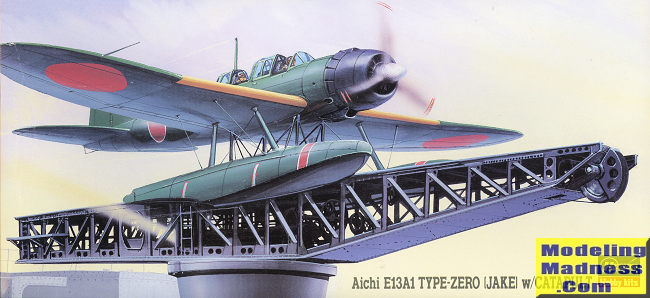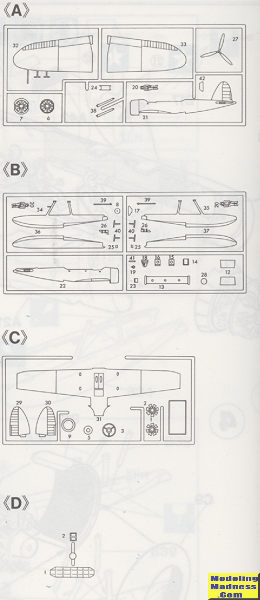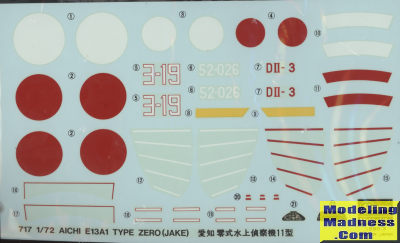
| KIT #: | 51830 (NP10) |
| PRICE: | 1200 yen when new |
| DECALS: | Three options |
| REVIEWER: | Scott Van Aken |
| NOTES: | 1995 release |

| HISTORY |
The Aichi E13A (Allied reporting name: "Jake") was a long-range reconnaissance seaplane used by the Imperial Japanese Navy (IJN) from 1941 to 1945. Numerically the most important floatplane of the IJN, it could carry a crew of three and a bombload of 250 kg (550 lb). The Navy designation was "Navy Type Zero Reconnaissance Seaplane" (零式水上偵察機).
In China, it operated from seaplane tenders and cruisers. Later, it was used as a scout for the Attack on Pearl Harbor, and was encountered in combat by the United States Navy during the Battles of Coral Sea and Midway. It was in service throughout the conflict, for coastal patrols, strikes against navigation, liaison, officer transports, castaway rescues, and other missions, along with some kamikaze missions in the last days of war.
One Aichi E13A was operated by Nazi Germany alongside two Arado Ar 196s out of the base at Penang. The three aircraft formed the East Asia Naval Special Service to assist the German Monsun Gruppe as well as local Japanese naval operations.
Eight examples were operated by the French Navy Air Force during the First Indochina War from 1945-1947, while others were believed to be operated by the Naval Air Arm of the Royal Thai Navy before the war. One example captured by New Zealand forces was flown by RNZAF personnel in theatre, but sank and was not repaired after a float leaked.
| THE KIT |
 The main kit
in this boxing was initially released in 1971, making it one of Hasegawa's
earliest releases. In 1978, the catapult was added providing another boxing
variant. This catapult was also shared with the E7K1 kit. Over the years, the
Jake has been reissued a number of times and combined with other kits a few
times for one of Hasegawa's double boxings.
The main kit
in this boxing was initially released in 1971, making it one of Hasegawa's
earliest releases. In 1978, the catapult was added providing another boxing
variant. This catapult was also shared with the E7K1 kit. Over the years, the
Jake has been reissued a number of times and combined with other kits a few
times for one of Hasegawa's double boxings.
You might expect a 50 year old tooling to be a bit on the basic side, and for the most part, that is true of this kit. For instance, the interior is a floor, three seat shapes, and three crew figures. That's it. The engine included a front and rear row along with an open or closed set of cowl flaps. The cowling has a single forward section and two side sections. A pair of decals are provided for the forward and aft instrument panels.
The kit has several holes to open depending on the markings option you choose. There are some on the fuselage side for radar antennas and some on the lower wing depending on the rigging. Same with the floats for the rigging. The wing is a single lower section with two upper halves. Note that wing antennas are molded in place so will need to be removed if not needed. Canopy is a single piece with fairly well defined frames. One then attaches the floats, exhaust and prop and that is it. As I said, not very parts intensive.
 The other
'kit' that is included is for the catapult. This is a fairly large assembly as
you might imagine. There are separate dollies depending on which aircraft type.
One needs to use thread or something similar to simulate the cable that runs
through the center section of the cat. The catapult has its own set of
instructions and is painted in an overall dark grey. The airplane has three
options. The first two are radar equipped and in dark green over light grey with
yellow wing leading edges. The second option has the simpler rigging. The third
is overall light grey as befits an early war aircraft. Since this is a fairly
recent boxing, the decals have white bits that are actually white. It will be
interesting to see how well these perform.
The other
'kit' that is included is for the catapult. This is a fairly large assembly as
you might imagine. There are separate dollies depending on which aircraft type.
One needs to use thread or something similar to simulate the cable that runs
through the center section of the cat. The catapult has its own set of
instructions and is painted in an overall dark grey. The airplane has three
options. The first two are radar equipped and in dark green over light grey with
yellow wing leading edges. The second option has the simpler rigging. The third
is overall light grey as befits an early war aircraft. Since this is a fairly
recent boxing, the decals have white bits that are actually white. It will be
interesting to see how well these perform.
| CONCLUSIONS |
It is surprising that no new tool kit of this plane has been done. If you want to build one of these in 1/72, then this is it. It does have the dreaded raised panel lines, though for most modelers this is not a big deal. One nice thing is that you can find the main subject on line for $15-20 and the one with the catapult for not much more.
| REFERENCES |
https://en.wikipedia.org/wiki/Aichi_E13A
July 2022 Copyright ModelingMadness.com. All rights reserved. No
reproduction in part or in whole without express permission from the editor. If you would like your product reviewed fairly and fairly quickly, please
contact
the editor or see other details in the
Note to
Contributors.